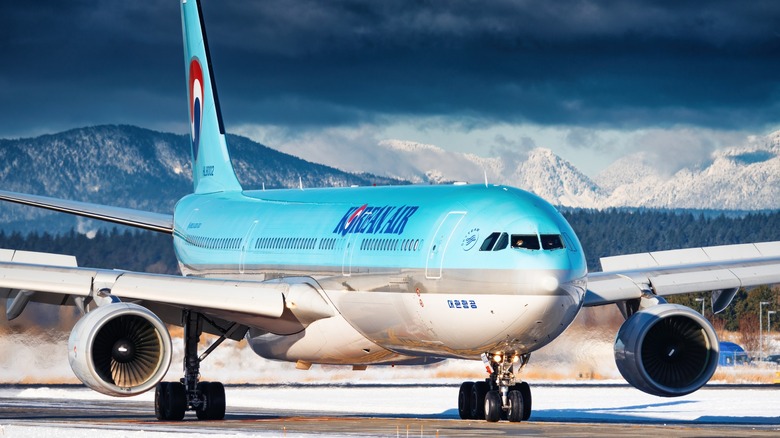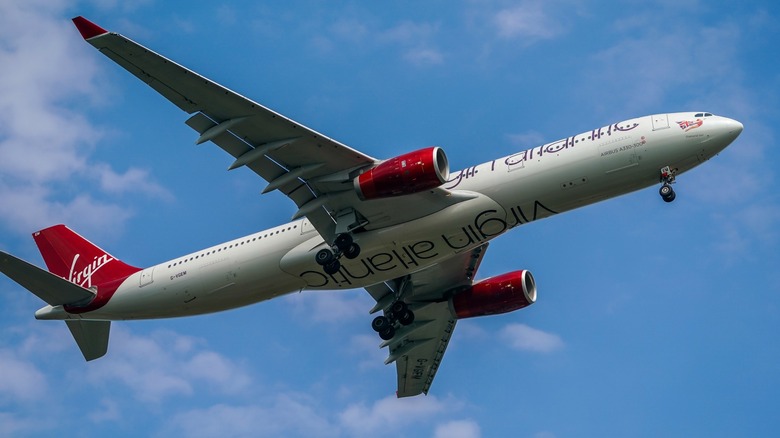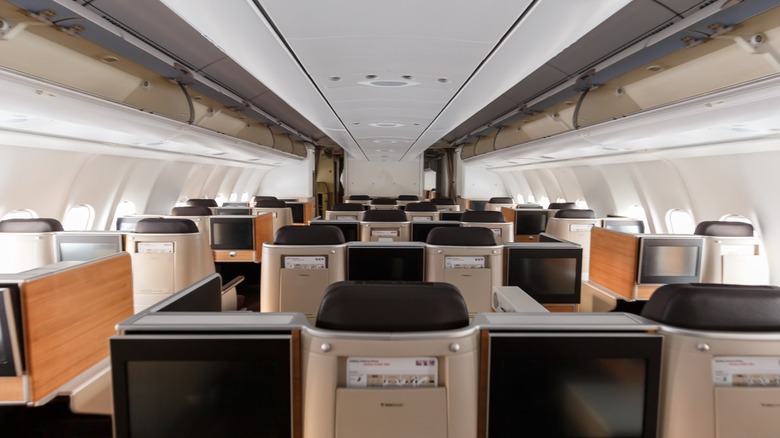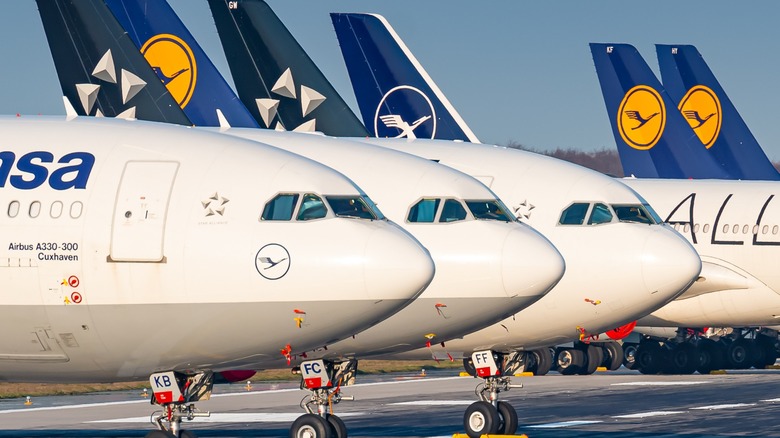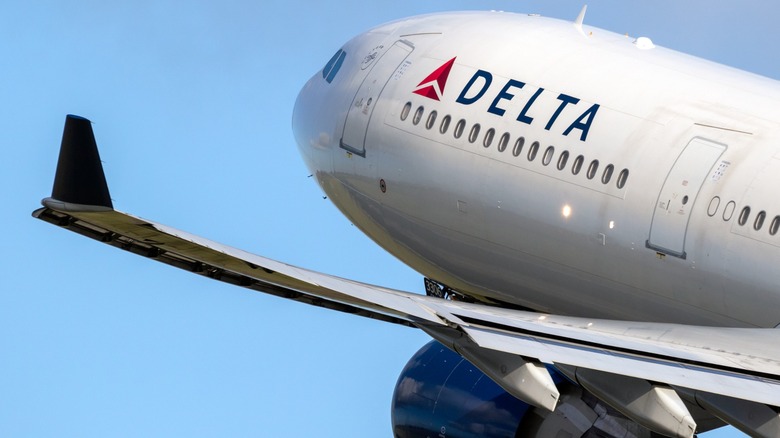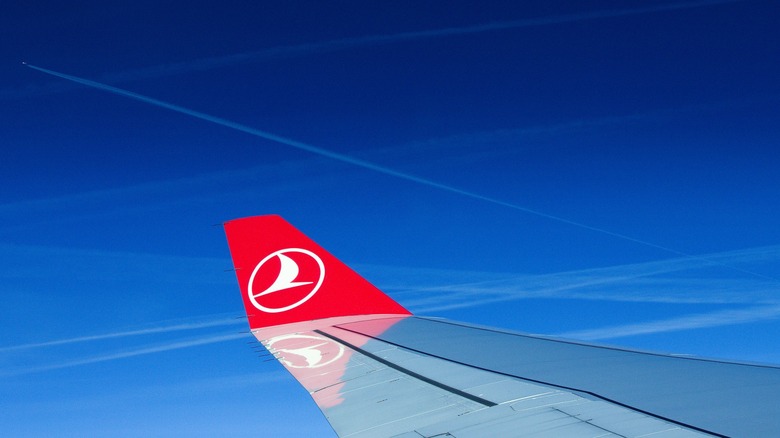Everything You Need To Know About The Airbus A330 And A340 Passenger Jets
Amidst ongoing concerns with Boeing and its 737 Max aircraft, it's helpful to cut through the negativity and remember that air is still the safest domain of travel. The real problem with air travel is comfort, and if you've been flying on common commercial airliners within the United States, chances are you've felt the pangs of an industry taking a sharp turn away from consumer comfort. That is, of course, unless you've had the pleasure of riding aboard an Airbus A330 or A340.
While the name "Airbus" may not instill much confidence in the comfort and convenience of flying an A330 and A340, the name isn't indicative of exactly what passengers enjoy when flying in one of these wide-bodied commercial craft. Introduced on Jan. 27, 1994, the Airbus A330 (and the subsequent A340) promised to elevate the company above competitors with a stylish interior where passengers could really get comfortable and mechanics that focused on efficiency.
What makes the A330 and A340 families unique, and how do they stand up to their predecessors and ongoing competition? There's much to know about these aerial behemoths, from the thought process behind their development to the passenger-friendly design elements that take them from being a flying city bus to a high-flying luxury experience.
They feature twin versus quad engines
On Jan. 27, 1986, the Airbus' Supervisory board agreed to move ahead with the development of the A330 and A340 models. Being developed so closely together, one would expect the similarities to be abundant. While the A330 does share some traits with the A340, including using the same fuselage and essentially a copy-and-paste job on the wings and tail, the two are also quite distinct in design and function.
One of the biggest differences between the A330 and A340 series Airbus is the number of engines. The A330, which is essentially the weaker of the two, features a twin-engine thrust. Its alternate doubles the number of engines, allowing it to take trans-oceanic flight paths. According to Airbus' vice president for strategic planning, Adam Brown, "North American operators were clearly in favor of a twin [engine], while the Asians wanted a quad. In Europe, opinion was split between the two."
When looking at the base option for each family, the A340-200 struggled in some areas to match the efficiency of the A330-200. The former may have been longer, at just under 195 feet compared to just under 194, but it could only carry 239 passengers compared to 253. Its quad-engine design did increase its range by over 2,000 miles, however. With later models, the balance shifts more in A340's favor, with the A340-600 shadowing the A330-900neo in capacity and range.
Putting a price on luxury air travel
After the two new Airbus models were approved in 1986, it would still take a village, so to speak, to make them a reality. That included Britain, West Germany, and France, contributing more than $2 billion. Though Britain only had to contribute $750 million, France and West Germany were in $1 billion each for the development of the new craft. Rival manufacturers Boeing and McDonnell Douglas voiced their concerns about the money being subsidized by one company.
While McDonnell Douglas president of commercial aircraft division James Worsham showed concerns over the cost of the A330 and A340, Boeing had a more critical take. The company's former executive vice president, Richard Albrecht, believed that Airbus' 17 years of operations prior to announcing the A330 and A340 should have been more than enough time to prop themselves up during development without government aid.
The later A330neo models' development costs are quite a bit more reasonable than Boeing's for its comparable 787. Though the differences between the two are fairly negligible, with the 787-9 having a smaller wingspan but being able to carry more passengers, there is a notable cost difference between them. The A330 and A340 were approximately $3.5 billion to develop, whereas the 787 topped out around $30 billion.
The A330 and A340 family portfolios
As of May 2024, there are four models of A330 available, two of which are now sold under the A330neo family. The largest of them, the A330-900, is capable of seating 460 economy passengers. In a three-class layout, that number drops to no more than 300 seats per A330-900. The A330-800 is more than 10 feet smaller than the 900, and can seat 406 passengers comfortably in an all-economy layout.
The A330-200 is nearly identical to the 800, save for the improved Rolls-Royce Trent 7000 engines and the wider wingspan in the 800. Similarly, the A330-300 is an older iteration of the A330neo's 900 model, though it does have a smaller maximum capacity of 440 in an all-economy setup.
Airbus' A340 family is a little less varied and includes a 200, 300, 500, and 600 series. While the smaller of the two families are closer in specs, there's more of a discrepancy between the larger models. For example, the A340-600 is 247 feet long compared to A330-900's 208 feet. It's also rated at a longer range of 7,800 miles against 7,200 miles. The biggest difference between the two is that, as of 2012, Airbus ceased production of any A340 planes while it's still delivering A330neo options. The biggest issue was simply a low number of orders placed for the A340 despite initially selling well.
United States Operators of the A330 and A340
There is quite an extensive list of operators flying Airbus' A330 and A340 family planes. However, when you break down that list and look only at United States operators, it paints a clear picture of who is providing U.S.-based airlines with their craft. As it turns out, there are absolutely no A340 planes in service in the United States. The majority of them are flying for Lufthansa out of Germany, which, as of May 2024, had 27 in its employ. As of 2022, Lufthansa was slowly phasing out the Airbus in favor of Boeing's 787.
Airbus never had a corner market of airlines in the United States, but it did, at one point, work with seven airlines. As of 2024, only four remain — Delta, Hawaiian, National, and Amazon Air. Of those, Delta has over 60 in service, including 22 A330-900s, making it the largest operator of Airbus' A330 line. The future for Airbus is going to look a little different, especially with operators like ITA Airways planning on disbanding its older A330s in favor of a fleet of A330-900neo by 2025.
Turkish Airlines' Deli Mike
If you're going to get to know Airbus' A340 fleet, you should also learn about Deli Mike. For clarification, "dely" is Turkish for "crazy," and the A340-300 plane that earned this nickname was certainly not the best introduction to the model for Turkish Airlines. Shortly after entering into service for the Turkey-based airline, Deli Mike started to show its more erratic side, starting with emergency lights that would turn on randomly and chase down the aisle. Lighting wound up being a common issue for Deli Mike, as the plan's external lights would also turn on at random intervals. Most curious, though, is that they would turn off only when staff went to inspect the issue.
From sounding the master alarm to turning on the wrong light when a passenger pressed their reading light, Deli Mike had many tricks up its sleeves. Unfortunately, not all of those tricks were harmless, such as veering off the runway in a September 2011 incident or failing to retract landing gear on takeoff after the plane had been relegated to charter flights in 2018. Turkish Airlines retired the craft in 2019 and eventually sold it to Africa Charter Airline, where it had one more mechanical failure during a flight from Johannesburg. As of November 2023, all that's known of Deli Mike's whereabouts is that it joined an Iranian operator and has been flying with it since.
